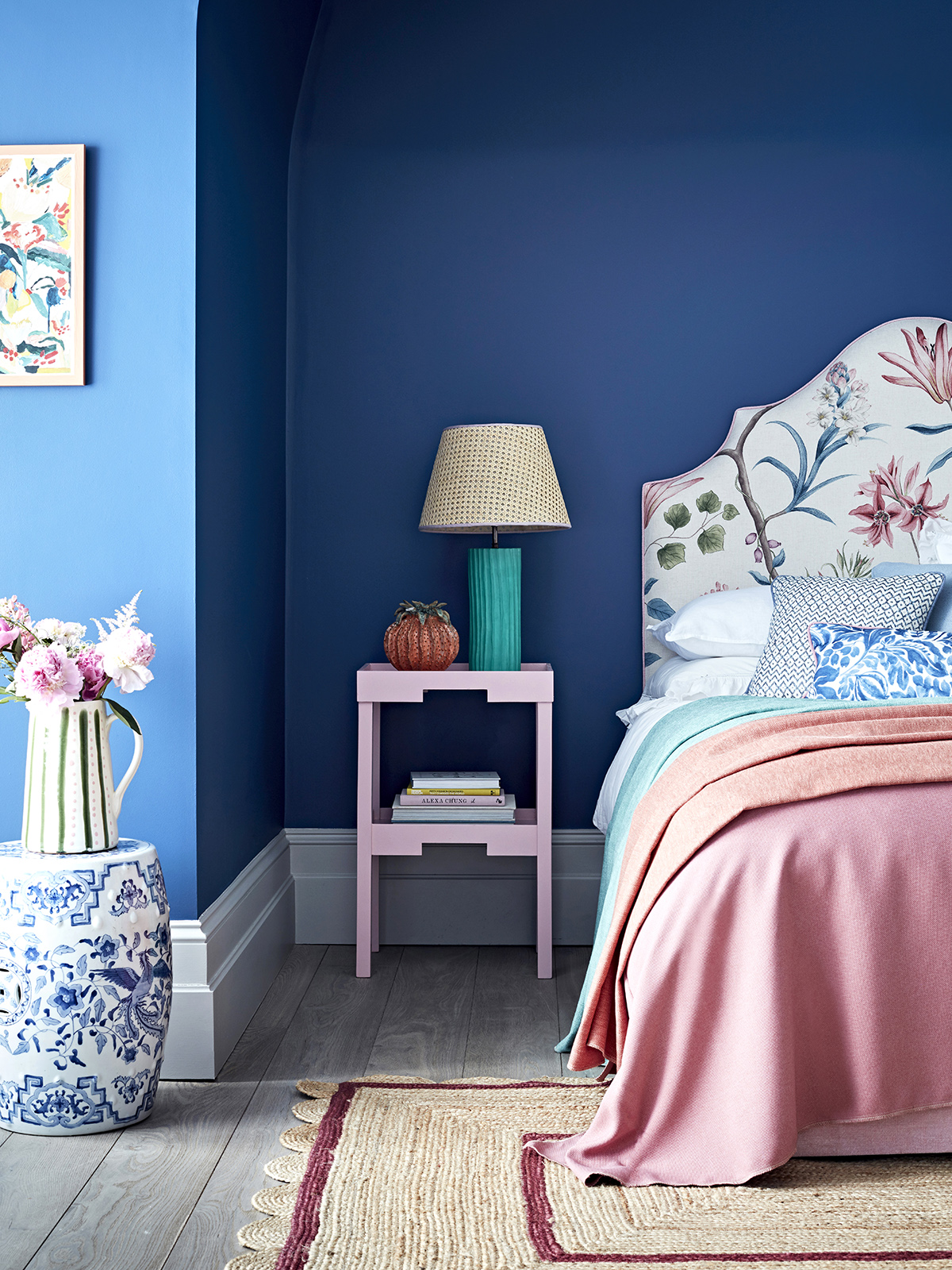How to lift your spirits with colour in the home

Oh my goodness who is struggling at this time of year!!!! I have to admit January is not my friend and I’m sluggishly trying to get motivated and blow away the post Christmas brain fog. If I’m honest, I’d really just love to be back on the sofa with a mince pie! But at the same time, 2020 is shaping up to be a really amazing year with loads of colour soaked projects in the pipeline. But if like me you need an antidote to the January blues, when everything else is grey then let me share with you how a pop of happy colour could be just the tonic.
Before I lurch into my quick-fire guide, remember that colour is such a personal thing and we all respond differently to it, so the headline here is to try and discover what your happy colours are. Listen to your gut and respond to which colours lift your mood and make you feel good. This time of year (for us Brits slumming out the long winter) we spend most our time indoors and so it’s key to get your interior colour palette just right. It’s super important to find out which hues really resonate with you and in turn create a space that will slap a smile on your face as soon as you walk through the door. I’m going to share some insights about how colour affects our psychology and how we feel and behave in a space because this is stuff you NEED to know before you pick up a paint chart!!
Happy Yellow

The Rug Company’s collection offers 15 beautiful shades including the Bay Blue rug shown here.
This is the ultimate sunshine colour and my go-to for injecting happy vibes or lifting the mood. Yellow exudes positivity, optimism and confidence and is, therefore, a great tone to consider introducing anywhere in your home. I prefer to add small pops of yellow dotted around, using small accents like cushions and vases rather than wall to wall colour. This is because yellow is very energising and too much can be overstimulating and quite frankly have a reverse effect! You feel stressed rather than uplifted! Have a think about which hue sings to you as it can be a real marmite colour. You may choose a soft buttermilk, a perky primrose, a zesty lemon or earthy mustard and not forgetting metallic tones like gold and brass fall into this category too. The warmth of yellow cuts through schemes based in cool tones of blue and grey so if you feel your room has a flat energy try popping a yellow accent in there and feel the happy effects.
Rejuvenating Green

Colour expert and creative director Anna Starmer knows a thing or two about creating captivating colour palettes and I adore this lush verdant green next to the soft powdery pink. Image from Love Colour: Choosing Colours to Live With luminarycolour.com Copyright photography by Anna Starmer.
Green is simply the colour of nature and creates a feeling of harmony, peace and reassurance, wherever it goes. I think we all need a bit of green in our homes and its easy to add with plants for example. So whether you’re drawn to fresh hues of apple, mint,and lime or more earthy tones like forest, sage, and olive, green in all its forms has the connotations of well being. It’s also having quite a moment in interiors. You can read my post on Dulux’s Colour Of The Year here, which is a soft pale misty green they’ve named Tranquil Dawn. Personally I’d avoid too much green though because it needs to sit against other colours to keep the feeling uplifting and fresh. Green is one of the most restful colours to live with as it sits in the middle of the colour spectrum making it least challenging to look at. Which is why it goes towards creating a relaxing atmosphere. However, too much of it can lead to a space feeling stagnant rather than energising. Personally I prefer a more lush and vibrant green and adore how well it sits next to pink, which is another of my feel-good colours.
Calming Blue

Creating a sophisticated backdrop, this deep navy blue allows the statement botanical Jackfruit fabric by Sanderson to really pop out
Universally the worlds favourite colour, blue is having a real moment in interior design right now. We seem to be drawn to its calming and contemplative effects in this ever crazy world! Again there is such an array of tones from vibrant cobalt to sultry navy, from pretty periwinkle to rich teal. Blue is a really versatile decorating choice and is the master of courting so many other colours, I almost treat it like a neutral, and pop greens, pinks, yellows, oranges next to it- almost anything goes! Beware that it can feel chilly and depressing if used in dark or cool north-facing rooms. It works well with warm natural tones like wood, sisal and creamy stone colours that help warm it up a little. According to colour psychology, blue suppresses the appetite, so a great colour if you are on a mission to cut back on calories this year!
Loving Pink

Soft pink accessories add a softeness and warmth to a cool blue bedroom. The walls are Yacht blue by Sanderson.
Pink has been phenomenally popular for the past decade in all areas of design but especially interiors. Previously banished to barbie doll mansions, pink is finally out of the closet and accepted as a colour of acceptable taste. And hurrah for that, as it’s a brilliant colour for lifting the mood and the feel-good vibes in your home. Pink is after all the colour of love and it exudes the feeling of nurturing and maternal love – and who doesn’t need their hoem to give them a bit of a hug at the end of a long day! Choose pink for rooms where you want to soften and relax, so the bedroom and living room are obvious places. Pale tones are not so good if you want to feel motivated so avoid in the home office for example. I think pink works well as both an accent and a wall colour and and sits well againts stronger colours. As a wall colour, a pale shade really acts like a neutral backdrop to other colours. As an accent, it can add softness to more sultry wall colours like blue, dark green or grey.
Energising red

Accent red beds painted in Cape red Intelligent Satinwood, Little Greene
Red is one of the most arresting and assertive colours you can introduce in your interior – it’s loud, proud and attention-grabbing! Red has a positive energy and is exciting so if this is the vibe you want to inject, pick a dramatic hue. Keep red in sociable areas like the dining room for example, as it stimulates conversation and conviviality. For this reason, kids seem to love it too so it works well in games rooms (maybe not so great in bedrooms!). But tread a little cautiously, too much of it in a scheme can start to feel aggressive and even feel overwhelming. It’s hotness can quickly feel firey so there is an argument to keep red out of kitchens or very sunny south-facing rooms. With its inherent warmth it’s lovely for spaces where you want to feel cosy, so pick one of the warmer browner reds and cuddle up.
Earthy brown

Deep Reddish Brown by Farrow & Ball
Literally the colour of earth, brown is extremely grounding. If you want to create a scheme that feels warm, welcoming and cosy, without the overtly energising properties of red or yellow, then opt for a fashionable terracotta or deep chocolate brown. Now I’ll admit I’ve not traditionally been a lover of brown. Its too all too ‘sensible shoes’, too dour for my personal tastes but then if you think of the timber tones of flooring and furniture, I realise I have plenty of brown in my home. Because I love a bright palette of colours, brown really helps to balance that, so don’t overlook it. It’s a great tone to have in the home as it adds warmth and depth and a real feeling of reassurance.
In a nutshell, it’s up to you to find your happy colours but begin by asking yourself how you want to feel in a room. And if you have a colour in mind that you love and connect, then you must have it in your home. Be it a vase, a cushion, a signature armchair, or on all four walls, cheer yourself up and indulge in your happy colours.
Credits: Written by Sophie Robinson. Research by Luisa Ferdenzi. Featured image at top: Donna Wilson lambswool cushions and throws exhibited at Top Drawer S/S20
comments
Just reading this rainbow post made me feel happier, thank you! You’ve also made me consider colours that I would never normally choose…









